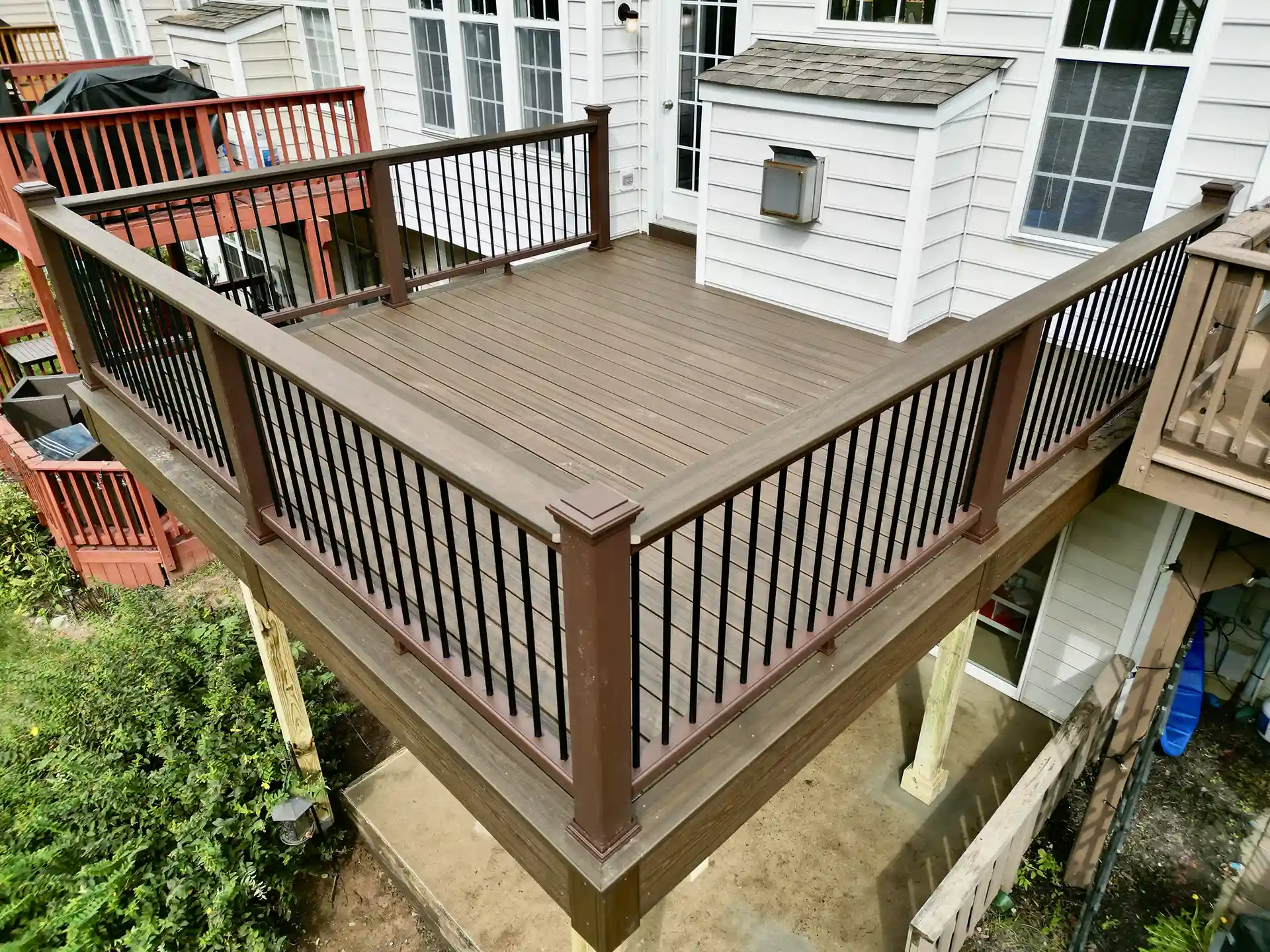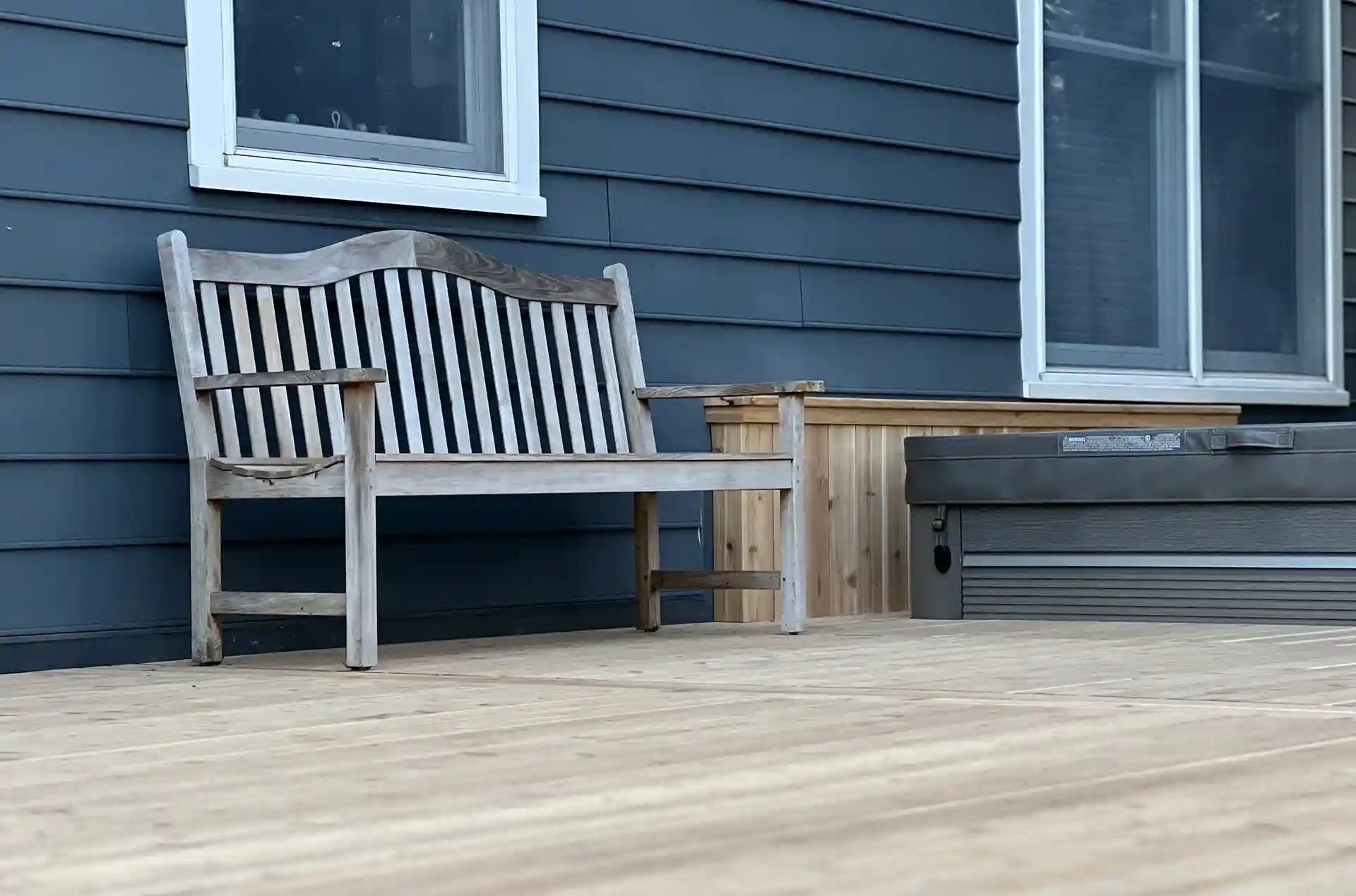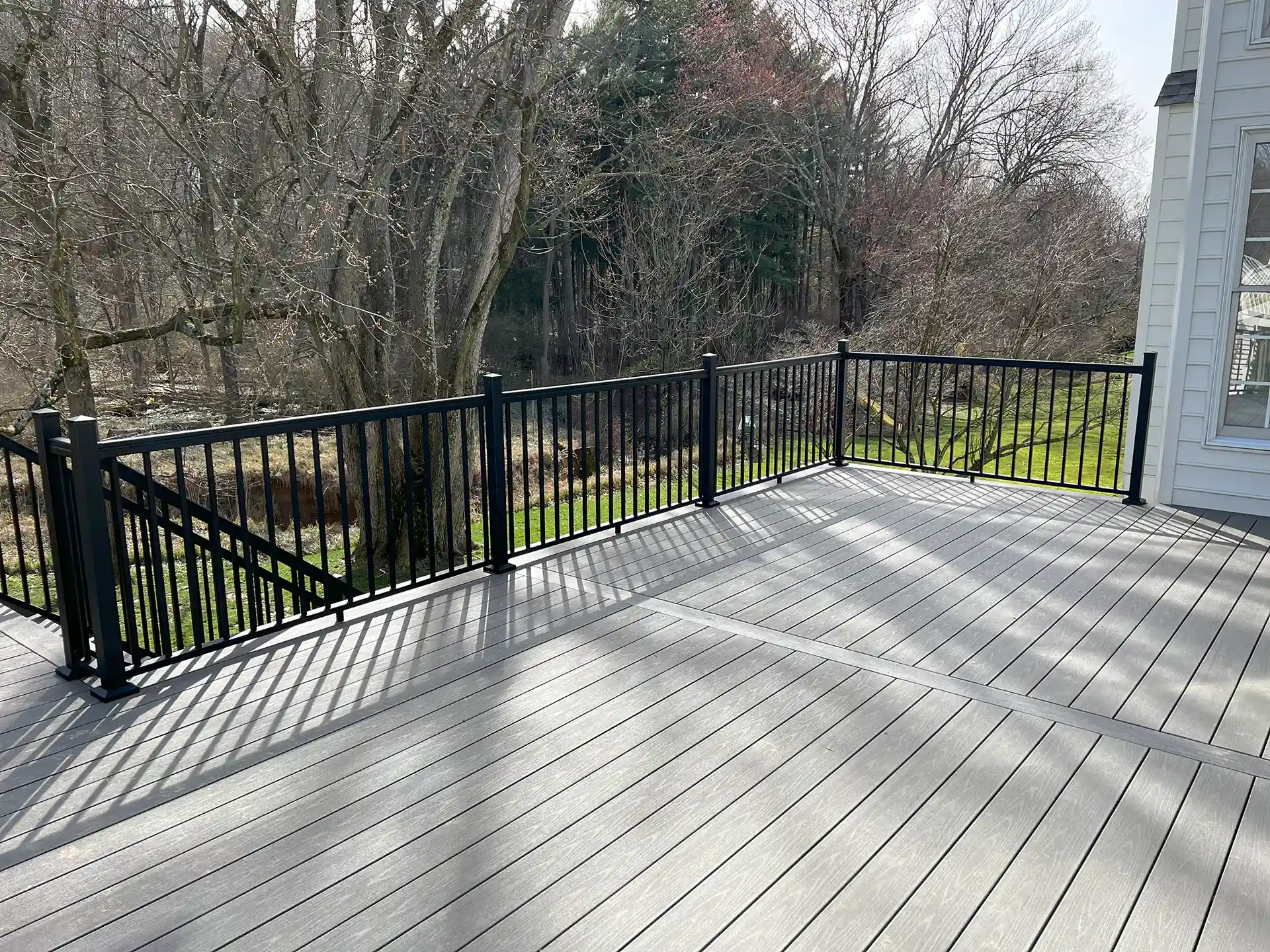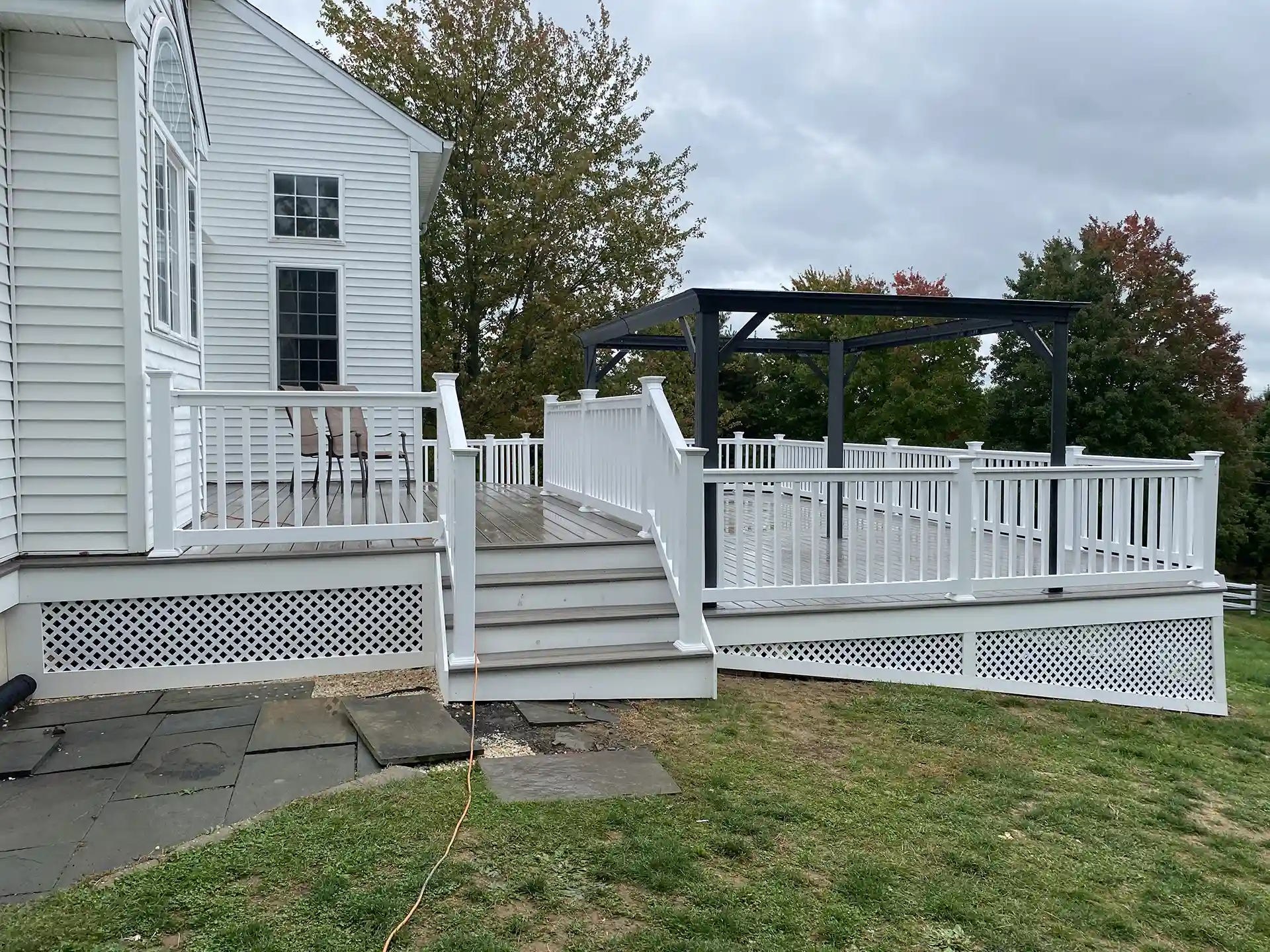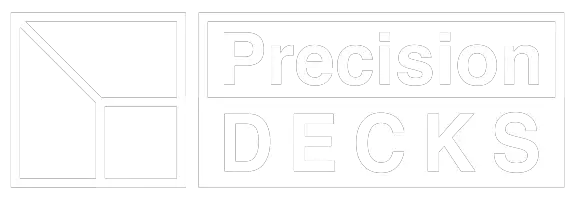Keeping your deck looking new protects your outdoor investment and extends its life. Deck maintenance ensures that even low-maintenance decking materials, like composite decks and specialty products, perform optimally every season. Routine care prevents costly repairs, structural failures, and surface deterioration, especially in climates like Chalfont, PA.
Why Should You Maintain Your Deck
Regular deck maintenance strengthens the structure, prevents moisture damage, and extends the life of the materials. A well-maintained deck stays safe, stable, and attractive, saving homeowners from expensive repairs and replacement costs.
- Prevent Moisture Intrusion: Sealing gaps and clearing debris stops mold growth and water infiltration.
- Maintain Structural Integrity: Inspecting fasteners, railings, and boards keeps the entire frame sound.
- Preserve Surface Appearance: Routine sweeping and rinsing prevent stains, discoloration, and surface degradation.
- Extend Deck Longevity: Proper care helps wood and composite decks retain strength and functionality over decades.
How Low-Maintenance Decks Reduce Long-Term Upkeep
Modern composite decking and mineral-based boards simplify deck maintenance by resisting the common threats that destroy traditional wood decks.
- Composite Decking Reduces Routine Work: Brands like Trex and TimberTech resist splintering, rotting, and insect attacks.
- Handles Weather Extremes: Capped composites perform well in Pennsylvania’s freeze-thaw cycles and humid summers.
- Easy Cleaning: Gentle soap and water washes effectively remove dust, dirt, and pollen buildup.
- Fewer Repairs: Composite and PVC boards resist cracking and warping, and there is a need for heavy repairs, which is common with untreated wood decks.
Regular Deck Maintenance vs Annual Deck Maintenance
Proper maintenance protects your deck’s structure, appearance, and long-term performance. Regular maintenance prevents moisture damage, surface stains, and fastener failures, helping both wood and composite decks stay strong through every season.
Type of Maintenance: Regular Deck Maintenance
Purpose: Prevent surface buildup, staining, and minor material degradation
Tasks Included:
- Sweep dirt, leaves, and debris weekly
- Rinse surfaces lightly with a garden hose monthly.
- Spot clean stains immediately using pH-neutral soap.
Recommended Frequency: Every 1–2 months, especially during active use seasons
Type of Maintenance: Annual Deck Maintenance
Purpose: Preserve overall deck integrity and address structural wear
Tasks Included:
- Conduct a full inspection of boards, fasteners, flashing, and railings.
- Identify and repair cracks, swelling, or corrosion.
- Deep clean deck surfaces with composite- or wood-safe cleaners
- Apply wood sealant if necessary (for wood decks only)
Recommended Frequency: Once a year, ideally in early spring or late fall
Tools and Materials You Need for Effective Deck Maintenance
Having the correct tools protects your decking investment and simplifies routine care.
| Tool or Material | Purpose | Best Use |
| Soft-Bristle Brush or Broom | Remove dirt without scratching | Sweep weekly to prevent buildup |
| Garden Hose with Adjustable Nozzle | Rinse surface debris gently | Use moderate pressure after storms |
| Low-Pressure Power Washer | Deep clean stubborn grime safely | Max 1,500 PSI, wide spray pattern |
| Mild Dish Soap or Composite Cleaner | Lift stains without surface damage | Use pH-neutral solutions only |
| Plastic Putty Knife | Clear debris between boards | Avoid metal tools to prevent gouging |
| Flashlight and Screwdriver | Inspect for loose hardware or hidden damage | Check twice yearly |
| Wood Sealant (for wood decks only) | Protects natural decks from water and UV | Apply every 12–24 months after cleaning and drying |
Key Deck Maintenance Practices to Preserve Strength and Appearance
Following smart deck maintenance tips helps extend the life of both composite and wood decks while preserving their appearance through every season.
Sweep Often to Prevent Buildup: Loose dirt, leaves, and organic debris can trap moisture against surfaces, potentially staining composite decking or accelerating wood deterioration.
Rinse After Storms or Heavy Pollen: A quick rinse with a garden hose removes salt, dust, and pollen, helping low-maintenance decks stay cleaner and reducing the risk of surface stains.
Spot Clean Stains Quickly: To prevent permanent discoloration, treat food spills, sunscreen oils, and organic stains immediately using a mild, composite-safe cleaner or dish soap.
Use Non-Abrasive Tools: Always use a soft-bristle brush or cloth to avoid scratching low-maintenance decking surfaces and damaging protective caps on composite materials.
Perform Seasonal Inspections: Check for cracked boards, loose railings, and any mildew or mold, especially after winter and summer, when decks are most susceptible to environmental stress.
Apply Sealant to Wood Decks Only: Cedar and pressure-treated decks benefit from an annual sealant application, while composite decks require no staining or sealing.
Proper Methods for Staining, Oiling, and Rinsing Deck Materials
Using the correct care method for your deck surface protects against moisture damage, fading, and structural deterioration.
Staining Protects Traditional Wood Decks: Pressure-treated lumber and cedar benefit from staining every 1-2 years to seal surfaces, block UV exposure, and prevent moisture infiltration.
Oiling Preserves Ipe and Hardwood Decks: Ipe deck maintenance relies on applying a specialized hardwood oil that maintains color stability and slows surface drying in hot, sunny climates.
Rinsing Maintains All Deck Types: Regular rinsing with a garden hose or low-pressure washer keeps low-maintenance decks, composite decking, and wood surfaces free from buildup and mildew growth.
Composite Decks Require No Stain or Oil: Composite materials from brands like Trex and TimberTech include protective capping that eliminates the need for additional surface treatments.
Follow the manufacturer’s guidelines carefully to protect your warranty and ensure optimal deck performance.
The Do’s and Don’ts of Smart Deck Maintenance
Do’s
- Sweep and Rinse Every 1-2 Weeks: Regularly clearing dirt, grit, and leaves prevents trapped moisture, surface staining, and clogged drainage paths between deck boards.
- Use pH-neutral, Composite-Safe Cleaners: Select cleaners specifically designed for composite decking to avoid chemical reactions that discolor or weaken the outer surface layers.
- Inspect Ledger Boards, Railings, and Fasteners Annually: Tighten mechanical connections and look for corrosion or water intrusion that could weaken the structural integrity.
- Follow Specific Guidelines for Composite and Wood Materials: Composite boards, such as Trex and TimberTech, require maintenance that is different from cedar, pressure-treated pine, or ipe decking.
Don’ts
- Use Chlorine Bleach Cleaners: Bleach degrades wood fibers and damages the polymer caps on low-maintenance decking and composite surfaces.
- Pressure Wash with High PSI: Excessive pressure over 1,500 PSI can strip protective finishes, fuzz composite surfaces, and raise wood grain, causing splinters.
- Ignore Minor Surface Mold: Allowing mildew to sit encourages deeper penetration into wood pores and composite textures, weakening long-term material.
- Apply Paint or Stain to Composite Decking: Composite materials are resistant to coatings, and applying stain or paint can cause peeling, surface rejection, and warranty violations.
Step-by-Step Guide to Wood Deck Maintenance
Maintaining a wood deck, such as cedar, pressure-treated pine, or ipe, requires specific, detailed care steps to preserve its strength, prevent surface damage, and protect against moisture infiltration.
| Step | Action | Purpose |
| 1. Clear the Deck Surface | Remove furniture, plants, and sweep all dirt and organic debris | Prevents moisture buildup and surface scratches |
| 2. Inspect for Damage | Check for splintering, popped nails, loose railings, and early signs of rot | Identifies structural problems before they worsen |
| 3. Clean the Surface | Use a wood-specific cleaner with a soft-bristle brush to remove stains, mildew, and algae | Prepares the wood for sealing or staining |
| 4. Rinse Gently | Rinse thoroughly using a hose or low-pressure washer (under 1,500 PSI) | Removes cleaner residue without damaging wood fibers |
| 5. Allow Full Drying | Let the surface dry for 24 to 48 hours, depending on humidity | Ensures stains or sealants adhere correctly |
| 6. Apply Stain or Hardwood Oil | Apply a penetrating stain for cedar or treated wood, or a specialty oil for ipe decking maintenance | Protects against UV damage, moisture, and color fading |
| 7. Schedule Regular Maintenance | Reapply sealant, stain, or oil every 12 to 24 months, depending on usage and climate conditions. | Extends the usable life and appearance of the deck |
Detailed Composite Deck Maintenance Checklist for Lasting Performance
| Step | Task | Timing | Material / Tool |
| 1 | Sweep dirt and organic debris from the deck surface | Weekly | Soft-bristle broom or leaf blower |
| 2 | Rinse the surface gently to remove pollen, dust, and grime | Monthly (Spring and Fall focus) | Garden hose with wide-fan nozzle under 1,200 PSI |
| 3 | Spot clean oil, food, and organic stains immediately | Within 24 hours of a spill | pH-neutral composite cleaner or mild dish soap |
| 4 | Deep clean the entire deck | Twice a year (Spring and Fall) | Composite-specific deck cleaner and nylon scrub brush |
| 5 | Inspect gaps between boards and check fasteners | Every 6 months | Screwdriver, inspection mirror, soft brush for clearing debris |
| 6 | Inspect moisture-prone zones for mold growth | Quarterly | Flashlight, mold-safe deck cleaner if needed |
| 7 | Review brand maintenance guidelines for updates | Annually | Manufacturer website (Trex, TimberTech, Deckorators) |
How to Conduct DIY Deck Inspections
Conducting regular DIY deck inspections helps spot minor issues before they become costly. Focus on structural, surface, and hardware conditions.
| Area | What to Check | Frequency |
| Surface Boards | Cracks, splinters, surface mold | Every 3 months |
| Fasteners | Rust, loose screws, or nails | Every 6 months |
| Railings/Stairs | Stability, cracks, loose bolts | Every 6 months |
| Board Gaps | Blocked drainage or debris | Every 3 months |
| Support Framing | Rot, sagging, and insect damage | Annually |
| Perimeter Flashing | Water intrusion signs | Annually |
When to Call a Professional Deck Maintenance Contractor
Specialized Tasks Professionals Perform:
- Using moisture meters and torque tools, diagnose structural shifting at ledger boards and framing connections.
- Replace rotted joists, rim boards, and stair stringers with pressure-treated or engineered materials that meet local code requirements.
- Chemically strip failed stains or sealants before applying new surface treatments to cedar, pressure-treated lumber, or ipe.
- Conduct warranty-compliant repairs on capped composite decking such as Trex Transcend, TimberTech AZEK, or Deckorators Voyage series.
When Professional Services Are Necessary:
- Visible sagging or bouncing in the deck platform indicates substructure failures that require certified repair methods.
- Black mold colonies on framing members or surface planks cannot be entirely removed with standard DIY cleaners.
- Hardware corrosion at galvanized brackets, joist hangers, or fasteners threatens the load-bearing capacity of the deck.
Material-Specific Contractor Skills:
- Properly identify and replace damaged PVC, mineral-based, or wood-plastic composite boards without voiding manufacturer warranties.
- Commercial-grade penetrating oils can be applied to dense hardwoods like ipe and Cumaru, utilizing proper surface preparation and curing times.
- Adjust or reinforce hidden fastening systems commonly used in modern, low-maintenance decks.
Important Clarification:
- My Deck Now specializes in designing and building low-maintenance and composite decks, but does not provide professional deck maintenance services.
Protect Your Deck Installation Investment with Smart Maintenance
Deck installations in Chalfont, PA, endure intense seasonal swings, from heavy snow to humid summers. A professional deck maintenance checklist ensures your structure remains safe, attractive, and functional throughout the year, whether you have a low-maintenance deck or a traditional wood installation..
At My Deck Now, we build decks that do not just survive the seasons — they own them. Our low-maintenance decks and composite designs are for real homes, weather, and life. If you’re serious about having a deck that stays strong and looks sharp without constant upkeep, contact us today and get a free estimate and start building with a team that knows what it takes.
FAQs About Deck Maintenance
What is routine deck maintenance?
Routine deck maintenance involves sweeping loose debris weekly, rinsing monthly during high pollen or dust seasons, and inspecting hardware and surfaces every six months. Composite decks, mineral-based composites, and PVC decks require pH-neutral cleaners, while wood decks may need periodic resealing.
What is the best way to preserve a deck?
The best way to preserve a deck is through scheduled cleanings, surface inspections, and material-specific care such as applying penetrating stains to wood or using composite-safe cleaners for capped boards. Protecting the deck from standing water, organic buildup, and UV exposure significantly extends its usable life.
How often should I reseal my deck?
Wood decks, such as cedar and pressure-treated lumber, should be resealed every 12 to 24 months, depending on the level of sun exposure and moisture. Composite decks, such as those made by Trex, TimberTech, and Deckorators, do not require sealing.
What is the best treatment for a wooden deck?
The best treatment for a wood deck is a high-quality, penetrating, oil-based stain that repels water while allowing vapor to escape, thereby preventing rot and surface cracking. Hardwoods like ipe require specialized hardwood oils to maintain their natural color and stability.
Should I seal my deck after power washing?
Sealing is recommended only for traditional wood decks after power washing once the surface has thoroughly dried for 24 to 48 hours. Composite decks should not be sealed, as their protective outer layers are designed to resist moisture without additional coatings.
Should decking be oiled or stained?
Depending on the species and local climate, wood decking benefits from either oiling or staining. Hardwoods like ipe require oil, while softwoods benefit from penetrating stains. Composite decking should never be oiled or stained, as these products can cause surface rejection and void the manufacturer’s warranties.

